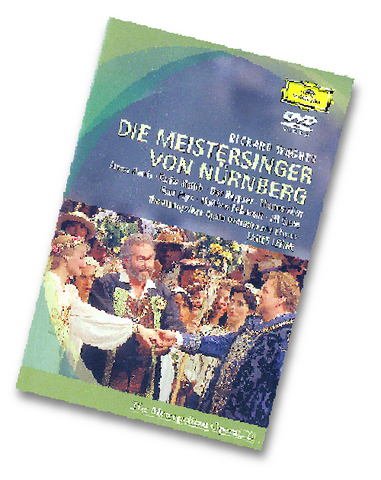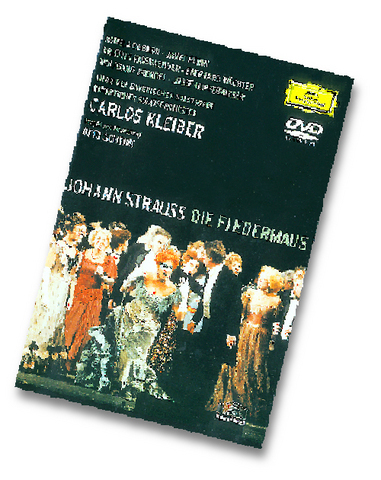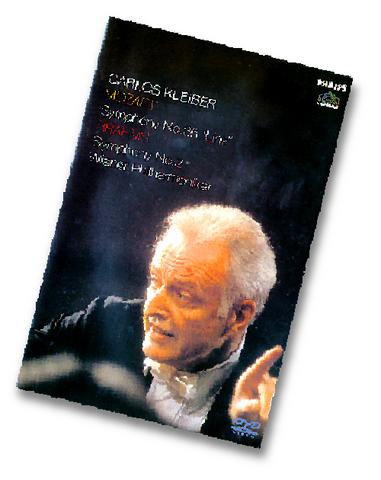The last few years have seen the appearance of a range of opera DVDs, many very fine. But few can compare with the extraordinary new Die Meistersinger von Nurnberg from The Metropolitan Opera, New York, in a performance dating from 2001. Watching something like this really can change your life.
Richard Wagner's Meistersinger is the greatest example in European culture of the Romantic era's fascination with the Middle Ages. It's a benign dream of social harmony before the arrival of what Marx termed the "cash nexus." It also displays Protestant Germany in its many facets, art with its roots in nature, and the creative process everywhere. Wagner without Meistersinger is heroic, dynamic and very frequently overwhelming, but with it he becomes incontestably congenial as well.

James Levine, with a smile both benign and ecstatic, conjures up wonders from the Metropolitan orchestra, the true stars of this 2001 production -- the vorspiele, played in the hushed dark, are glories in themselves. But when the curtain goes up on the beautiful sets (which for Act Two gets instant applause) and the soloists begin their long tasks, enjoyment only increases. This is an opera about music itself and here music of the highest order is given a treatment that avoids all temptations to be surprising or incongruous, but is offered instead in a naturalistic style the composer would surely have been delighted with.

Few will complain about the colorful crowd scenes, but for me it was the more introspective ones -- Act One, and Act Three, Scene One -- that were most telling. The latter in particular is beautiful beyond belief, culminating in a Quintet where the looks on the singers' faces tell even more than their entranced voices convey.
Surprisingly, the soloists are in some ways inappropriate to their roles. Walther is too large, Eva and David insufficiently young, Sacks possibly past his peak as a singer, and so on. But with the inspiration at such a high level it really doesn't matter. And this is typical of opera -- the potential musical rewards are so huge that audiences have always been prepared to make allowances. The fat lady -- not in evidence here -- was always welcome if she alone could give expression to the full splendor of the score.

James Morris as Sachs, wise and sympathetic in a way Wagner's enemies have never been able to credit, leads an all-star cast. Ben Heppner makes a marvelous Walther, puzzled and diffident even while remaining vocally thrilling. Rene Pape is a sympathetic Pogner, while Karita Mattila overcomes all obstacles to create a compelling Eva. High marks, too, for Matthew Polenzani's good-natured David and Jill Grove's genial Magdalene. But the acting prize must go to Thomas Allen whose Beckmesser -- trotting, wincing, flashing false smiles -- would be Oscar material if this were a Hollywood film. But these days opera singers on DVD really do need to be near-flawless -- never before have their performances been recorded for posterity in such detail.

All in all, humanity is the hallmark of this magnificent production, as manifest in the warm yet ringing orchestral playing as in the conviction and contentment radiated by the singers.
The avalanche of recent DVDs featuring the late Carlos Kleiber as conductor includes a 1987 version of Johann Strauss' operetta Die Fledermaus from the Bavarian State Opera. The bottom-pinching absurdities of bourgeois high jinks are at the heart of this alcoholic confection, replete with head-spinning waltzes, a frantic polka and endless jokes about hangovers and delirium tremens. It may have some memorable tunes, but after Meistersinger it's like a mosquito's whine after a lion's roar. Sexual repression is at the heart of it, of course. Nevertheless, if you like the frivolous music and can tolerate the sight of the middle classes at play, you'll have no complaints about this high-spirited and colorful production.
Kleiber is rather more in the camera's eye in a 1991 concert from Vienna's Musikverein. He paints the score with his hands and body, emoting to the music rather than being content to mark the beat, and this suits the DVD medium well. Mozart's Linz and Brahms's second symphonies are featured, with sumptuous sound to match the opulent surroundings. No period instruments are in evidence, but with the great Vienna Philharmonic no such gambits are necessary. The concert is marginally less striking than the one featuring Brahms' Fourth (reviewed in Taipei Times, Dec. 5, 2004), but is very fine nonetheless. In addition, the unlimited opportunities DVD gives to re-watch any section offers a spectacular opportunity to get to know these wonderful scores painlessly and in detail.
But DVD has another virtue -- it helps your ears accustom themselves to strange sounds as well. Tan Dun first heard stone-drumming (knocking stones together), leaf-blowing and other Miao music skills in the village of Xiangxi in China's Hunan province. To these he added a solo cello and Western symphony orchestra to produce his concerto The Map, commissioned by Yo-yo Ma and the Boston Symphony Orchestra. After repeating the work with the Shanghai Symphony and cellist Anssi Karttunen, he decided to take the whole thing down to Hunan (involving three days' travel overland), and perform it in the village that gave it birth. This DVD gives the performance that resulted, on a stage built over the local river, plus a film of almost equal length containing Tan Dun's account of the process, chats with the locals, archive footage and so on.
It's legitimate to wonder how much the villagers really enjoyed this strange music, but DVD watchers are in a better position to get acquainted with it. Once again, the format proves enjoyable and educatiional in almost equal measure.

Taiwan Power Co (Taipower, 台電) and the New Taipei City Government in May last year agreed to allow the activation of a spent fuel storage facility for the Jinshan Nuclear Power Plant in Shihmen District (石門). The deal ended eleven years of legal wrangling. According to the Taipower announcement, the city government engaged in repeated delays, failing to approve water and soil conservation plans. Taipower said at the time that plans for another dry storage facility for the Guosheng Nuclear Power Plant in New Taipei City’s Wanli District (萬里) remained stuck in legal limbo. Later that year an agreement was reached

What does the Taiwan People’s Party (TPP) in the Huang Kuo-chang (黃國昌) era stand for? What sets it apart from their allies, the Chinese Nationalist Party (KMT)? With some shifts in tone and emphasis, the KMT’s stances have not changed significantly since the late 2000s and the era of former president Ma Ying-jeou (馬英九). The Democratic Progressive Party’s (DPP) current platform formed in the mid-2010s under the guidance of Tsai Ing-wen (蔡英文), and current President William Lai (賴清德) campaigned on continuity. Though their ideological stances may be a bit stale, they have the advantage of being broadly understood by the voters.

In a high-rise office building in Taipei’s government district, the primary agency for maintaining links to Thailand’s 108 Yunnan villages — which are home to a population of around 200,000 descendants of the Chinese Nationalist Party (KMT) armies stranded in Thailand following the Chinese Civil War — is the Overseas Community Affairs Council (OCAC). Established in China in 1926, the OCAC was born of a mandate to support Chinese education, culture and economic development in far flung Chinese diaspora communities, which, especially in southeast Asia, had underwritten the military insurgencies against the Qing Dynasty that led to the founding of

Artifacts found at archeological sites in France and Spain along the Bay of Biscay shoreline show that humans have been crafting tools from whale bones since more than 20,000 years ago, illustrating anew the resourcefulness of prehistoric people. The tools, primarily hunting implements such as projectile points, were fashioned from the bones of at least five species of large whales, the researchers said. Bones from sperm whales were the most abundant, followed by fin whales, gray whales, right or bowhead whales — two species indistinguishable with the analytical method used in the study — and blue whales. With seafaring capabilities by humans